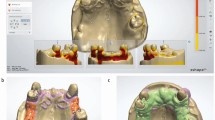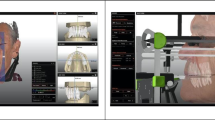Abstract
3D printed dentures are becoming a reality with the development of intraoral scanners and material availability for additive manufacturing. Described herein are some workflows that are designed to accurately capture patient information for improved fabrication of well-fitting complete dentures that are done traditionally, immediately or replicated dentures. Techniques described include traditional methods combined with digital methods for improved fit and function of the prothesis while simultaneously achieving an expedited delivery of the prosthesis.
Similar content being viewed by others
Avoid common mistakes on your manuscript.
Quick reference/description
In the event of intraoral scanners improving the ability to scan edentulous arches, impression materials and casts, the digital workflow for complete dentures is becoming a reality. This technology is effective in combing two steps and saving a clinical session as noted in Table 1. It has been established that following the scanner manufacturers prescribed scan path results in accurate production of a prosthesis [1].
In edentulous mouths, the moving soft tissues in the vestibules are the most difficult to capture with intraoral scanners. This article proposes a variety of workflows that combine digital and analog techniques to digitize a fully edentulous arch [2].
Recent studies have indicated that additive manufacturing (3D printing) allows better adaptation of complete dentures to soft tissue as compared to acrylic dentures. This is the impetus to adapt to digital pathways when using 3D printing to manufacture the denture [3]. Other studies have demonstrated better tissue adaptation with less patient discomfort and tissue ulcerations with 3D printed dentures. However, esthetics was better in conventionally processed dentures [4]. Digital technology has been effective in saving chair time and provides a cost saving benefit for the patient [5].
Currently denture resins such as Lucitone Digital Print 3D Denture resin are available for fabrication of dentures. Such resins have improved impact resistance and flexural strength. This article will illustrate how 3D printing of complete dentures will decrease chair time for the patient and improve accuracy of the fit of the denture.
Indications
In Table 2, we suggest considerations for different clinical situations when considering digital full denture workflows.
Materials/instruments
-
Intraoral scanner
-
Edentulous stock impression trays
-
Custom fabricated impression Trays
-
Border molding material if indicated.
-
Impression material of choice with corresponding tray adhesive (irreversible hydrocolloid or light bodied poly vinyl siloxane)
-
Printed base plate and Wax rims.
-
Printed denture teeth
Clinical sequence of procedures
Complete dentures (completely edentulous)
First appointment
-
(a)
If the patient has alveolar ridges with minimal undercuts a direct intraoral scan is possible. Follow the scan path indicated by the manufacturer of your intraoral scanner. Alternatively, take an ideal preliminary irreversible hydrocolloid impression using edentulous stock impression tray. This impression can be poured or scanned directly if time permits. See Figs. 1, 2 and 3.
Fig. 1 Fig. 2 -
(b)
The laboratory prescription should request:
-
3D printing of master casts, Record base & Wax Occlusal Rim. (Fig. 4).
-
Second appointment
-
(a)
Try the record bases to insure proper extensions in the buccal vestibules and adequate fit of the record bases to the soft tissue. If needed, border mold the record bases and make a light body polyvinyl siloxane (PVS) wash impression in the record base.
-
(b)
With both upper and lower record bases/rims in place and finalize the clinical jaw relation record. Patients should be guided to centric relation position at the proper vertical dimension.
-
Confirm vertical dimension of occlusion (VDO) and centric relation (CR)
-
Mark the midline, canine lines and high lip line.
-
Take a bite registration with fast set PVS (Blu-Mousse) material.
-
-
(c)
Select teeth and shade (Use Dentsply Portrait IPN mold and shade guide).
-
(d)
The laboratory prescription should include:
-
1.
Request final scanning of the relined denture base and set up of teeth
-
2.
List mold, shade, and occlusal scheme selected for patient.
-
3.
Return dentures for wax try in
-
1.
Third appointment
-
(a)
Wax try-in denture: assess VDO, CR, phonetics & esthetics.
The teeth are printed in three blocks: right posterior, anterior and left posterior, see Fig. 5. If any changes are required the printed teeth can be detached from the base, sectioned, and repositioned using wax. Once satisfied with tooth positions, a fast set PVS bite should be taken to record the bite registration.
-
(b)
Confirm gingival shade.
-
(c)
The laboratory prescription should request.
Final printing of denture with confirmed gingival shade and return for delivery.
Fourth appointment: delivery of dentures
-
(a)
Check fit of denture, adjust intaglio surface for pressure spots using pressure indicating paste. Check for proper extensions in vestibule and frenum areas using disclosing wax.
-
(b)
Ensure vertical dimension is correct and centric relation is repeatable, by checking phonetics and esthetics.
-
(c)
Bilateral Balanced occlusion is mandatory if interferences are noticed proceed with clinical remount.
Replicating existing dentures
In cases where a patient has an existing denture and requires a new one, go through this checklist to determine if this is a good workflow. This eliminates significant chair time for the patient and the provider. Most laboratories can process these dentures within a few days.
Checklist to decide if denture replication is appropriate:
-
(a)
The dentition is not worn.
-
(b)
Patient is satisfied with tooth arrangement and esthetics of teeth including shape and arrangement. Tooth and gingival shade can be corrected, note patient’s preference if shade is to be changed.
-
(c)
Vertical dimension and centric relation are correct.
First appointment
-
1.
If the above conditions are all true, reline the denture with light bodied PVS to give the intaglio surfaces a better fit.
-
Ensure you go through border molding movement to record the anatomy as the material sets.
-
Trim excess material to ensure smooth surfaces. See Fig. 6.
-
Double check that the vertical is correct with the relined dentures.
-
-
2.
Scan the entire denture (inside and outside). After scanning, remove reline material and clean dentures. Return them to the patient.
-
3.
The laboratory prescription should request:
-
Replicate the denture that has been scanned. Specify tooth and gingival shades.
-
Second appointment
-
Deliver Dentures (same steps as Complete denture delivery above).
Immediate dentures
An immediate denture can be defined as a denture that is fabricated while a few anterior teeth remaining. This allows the patient some aesthetic satisfaction as he/she transitions into a complete denture. Ideally, the posteriors (premolars and molars) are extracted before starting the fabrication of the complete immediate denture. The alveolar ridge is allowed to heal for 6–8 weeks giving the denture better stability.
First appointment
-
(a)
In the illustrated case below, the vertical dimension was preserved by the remaining teeth in both arches (Fig. 7). Posterior teeth to be replaced were selected and noted in the laboratory prescription.
-
(b)
An intraoral scan was done of both upper and lower arches.
-
(c)
The laboratory prescription should request.
-
1.
3D Printing of a master cast, record bases for both upper and lower arches. The upper arch should have a record base with windows to allow for the existing teeth to come through simultaneously checking for flange extensions in the entire upper vestibule (Fig. 8).
-
2.
Teeth in upper posterior to be set for wax try in. The patient did not desire a lower denture, but we requested a lower wax rim to stabilize the bite.
Fig. 7
-
1.
Second appointment
Posterior wax try in of dentures.
-
(a)
Check fit of the record base, alterations on the fit can be done by Border molding the record bases and a light body PVS wash impression in the record base. Remove any impression material that interferes with the wax try in
-
(b)
Confirm VDO, CR and tooth arrangement. Ensure the patient is satisfied with the arrangement of the teeth and the selected shade.
-
(c)
Select the gingival shade.
-
(d)
The laboratory prescription should request:
-
1.
Scanning of the intaglio surface of the record base if it was relined.
-
2.
Virtual extraction of remaining upper anterior teeth and addition of these teeth to the denture.
-
3.
Request for the Complete upper denture case to be printed with selected gingival and tooth shades and returned for delivery.
-
1.
Third appointment
Denture Delivery (Fig. 9).
Denture delivery: the position of the anterior teeth in the denture was determined by the existing dentition from the original scan. The patient had a good midline and smile line. He was satisfied with the general aesthetics of his anterior teeth which allowed our dental laboratory to mimic the original anterior teeth in his new immediate denture. Patients should always be cautioned in Immediate dentures when an anterior try in of the teeth is not completed, aesthetics and function may be compromised as a result
For Immediate dentures, patients should be reminded that relines or remakes may be necessary as the bone remodels in the next few months.
Pitfalls and complications
A basic understanding of intraoral scanners is required to scan edentulous or partially edentulous ridges. In general, all scanners have decreased accuracy if the user does not adhere to the manufacturer’s prescribed scan paths. The object of utilizing digital workflows to fabricate dentures for patients is to improve fit and function of the dentures. It can also decrease chair time for both patient and provider. However, the basic principles of denture fabrication are still essential for a successful outcome.
Digital workflows should be established in conjunction with a dental laboratory. This would ensure achievable results and realistic timelines to complete the work. Materials for 3D printing are constantly changing, improving our abilities to provide the best product for our patients. At present, color choices for gingival shades are limited for 3D printed dentures. Teeth for 3D printed dentures are monochromatic, perhaps not appropriate for patients with high esthetic concerns.
References
Clark WA, Duqum I, Kowalski BJ (2019) The digitally replicated denture technique: a case report. J Esthet Restor Dent 31:20–25. https://doi.org/10.1111/jerd.12447
Kouveliotis G, Tasopoulos T et al (2022) Complete denture digital workflow: combining basic principles with a CAD-CAM approach. J Prosthet Dent 127(4):550–555. https://doi.org/10.1016/j.prosdent.2020.12.024
Clark WA, Brazile B, Matthews D, Solares J, De Kok IJ (2021) A comparison of conventionally versus digitally fabricated denture outcomes in a university dental clinic. J Prosthodont 30:47–50. https://doi.org/10.1111/jopr.13273
Kim TH, Bo Huh J, Lee J, Bae E-B, Park CJ (2021) Retrospective comparison of postinsertion maintenances between conventional and 3D printed complete dentures fabricated in a predoctoral clinic. J Prosthodontics 30:158–162. https://doi.org/10.1111/jopr.13322
Bradford Smith P, Perry J, Elza W (2021) Economic and clinical impact of digitally produced dentures. J Prosthodontics 30:108–112. https://doi.org/10.1111/jopr.13283
Author information
Authors and Affiliations
Corresponding author
Additional information
Publisher's Note
Springer Nature remains neutral with regard to jurisdictional claims in published maps and institutional affiliations.
Rights and permissions
Springer Nature or its licensor (e.g. a society or other partner) holds exclusive rights to this article under a publishing agreement with the author(s) or other rightsholder(s); author self-archiving of the accepted manuscript version of this article is solely governed by the terms of such publishing agreement and applicable law.
About this article
Cite this article
Khalili, M., Segal, A.G. & Weinstein, G. Clinical guidelines for digital complete denture workflows. Clin Dent Rev 7, 2 (2023). https://doi.org/10.1007/s41894-023-00126-z
Received:
Accepted:
Published:
DOI: https://doi.org/10.1007/s41894-023-00126-z













